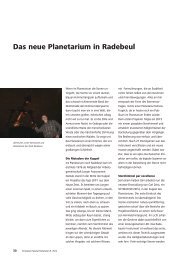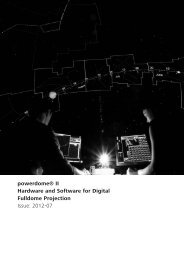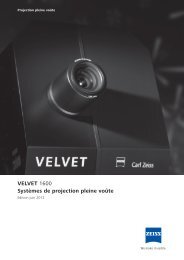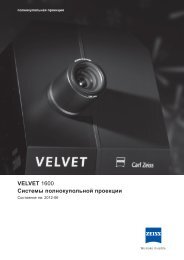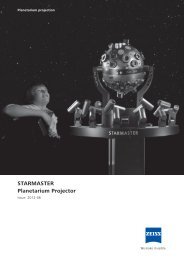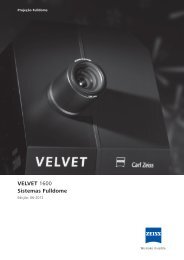Innovation Special Planetariums 9 - Carl Zeiss Planetariums
Innovation Special Planetariums 9 - Carl Zeiss Planetariums
Innovation Special Planetariums 9 - Carl Zeiss Planetariums
You also want an ePaper? Increase the reach of your titles
YUMPU automatically turns print PDFs into web optimized ePapers that Google loves.
VELVET Duo<br />
Ralf Hasse, Head R&D<br />
<strong>Carl</strong> <strong>Zeiss</strong>, Planetarium Division<br />
In developing VELVET projectors, <strong>Carl</strong> <strong>Zeiss</strong> followed its ongoing<br />
ambition to offer its customers increasingly better projector<br />
solutions for use in planetariums. Thanks to our wealth of<br />
experience in making optical instruments and to leading-edge<br />
manufacturing technologies, we saw a chance to creating a<br />
projector that would remedy the most serious shortcoming of<br />
all commercial video projectors. VELVET delivers an absolutely<br />
black image background – a prerequisite for unimpaired superimposition<br />
of analog star and digital video projection.<br />
Developing such a projector for small-lot production is a<br />
commercial risk. Many technological obstacles had to be<br />
overcome – which we did, not least thanks to close cooperation<br />
with our users. Our sincerest thanks are due to the first<br />
purchasers of a powerdome®VELVET system for their confidence<br />
in this new technology.<br />
Meanwhile there are six permanent VELVET installations, and<br />
three more orders have been landed. The response to the<br />
projection quality is exceedingly encouraging. All our VELVET<br />
customers report increases in attendance figures.<br />
At present we are pursuing two further advancements: an<br />
increase in resolution by employing DLP ® chips with WQXGA<br />
resolution (1600 lines), and the configuration of systems with<br />
two VELVET projectors for small domes (VELVET Duo). The new<br />
set of chips will be used in all VELVET projectors ordered from<br />
now on. A VELVET system configured with six to eight image<br />
channels, as recommended for large domes, achieves an efficient<br />
resolution of 4 k; with ten projectors, this figure is pushed<br />
to 5 k plus.<br />
For domes up to 12 m in diameter, we can offer a two-channel<br />
solution with close to 3 k resolution. The projectors are arranged<br />
at the periphery or next to an existing central planetarium<br />
projector.<br />
16 <strong>Innovation</strong> <strong>Special</strong> <strong>Planetariums</strong> 9, 2012<br />
Configuration example: SKYMASTER ZKP 4 with VELVET Duo for domes up to<br />
12 m in diameter. Artwork: Klaus Fankhänel.<br />
In actual operation, the image geometry has proved to be stable<br />
in all VELVET systems installed. In case of a lamp change or<br />
projector replacement, corrections may become necessary. For<br />
automatic calibration we have designed a camera system to<br />
be permanently installed at the dome periphery. It will perform<br />
automatic calibration within about 15 minutes.<br />
VELVET Configuration examples<br />
Dome<br />
diameter<br />
12 m<br />
(40 ft)<br />
15 m<br />
(50 ft)<br />
18 m<br />
(60 ft)<br />
23 m<br />
(75 ft)<br />
25 m<br />
(82 ft)<br />
Channels 2 5 6 8 10<br />
Placement center /<br />
periphery<br />
periphery periphery periphery periphery<br />
Resolution (ca.) 3 k 4 k 4.5 5 k 5 k<br />
Pixel size (') 3.9 2.3 2.2 2.1 1.9





